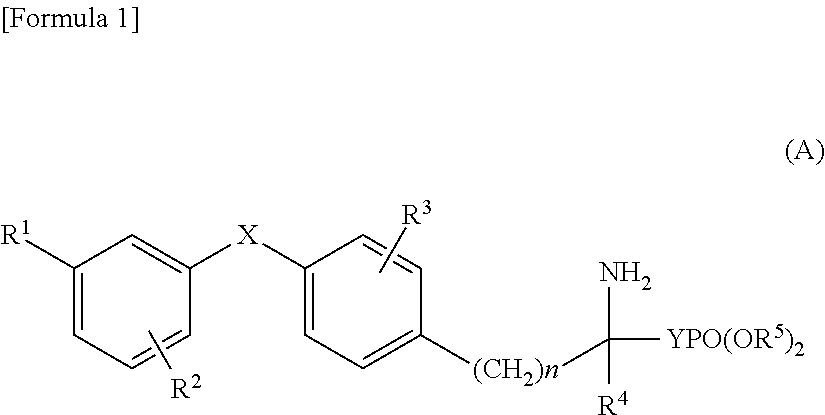Diphenyl sulfide derivative and pharmaceutical product which contains same as active ingredient
- Summary
- Abstract
- Description
- Claims
- Application Information
AI Technical Summary
Benefits of technology
Problems solved by technology
Method used
Image
Examples
reference example 1
(2R,5R)-2-allyl-2-(4-bromo-2-chlorophenyl)ethyl-3,6-dimethoxy-5-isopropyl-2,5-dihydropyrazine
[0110]
[0111]Under an argon atmosphere, an n-butyllithium-hexane solution (1.60 mol / L, 11.16 mL) was added at −78° C. to a solution of (5R)-2-allyl-3,6-dimethoxy-5-isopropyl-2,5-dihydropyrazine (3.64 g) in tetrahydrofuran (60 mL) to form a reaction solution. This reaction solution was then stirred at −78° C. for 30 minutes. A solution of 4-bromo-2-chloro-1-(2-iodoethyl)benzene (6.73 g) in tetrahydrofuran (20 mL) was added to the reaction solution, and the reaction solution was stirred at −78° C. for 30 minutes and then at 0° C. for 1 hour. Water was added to the reaction solution, and the reaction solution was extracted with ethyl acetate. The extract was washed with water and saturated brine in that order, and then dried over anhydrous sodium sulfate. The anhydrous sodium sulfate was removed by filtration, and then the solvent was removed by distillation under reduced pressure. The resultant...
reference example 2
Methyl
(R)-2-allyl-4-(4-bromo-2-chlorophenyl)-2-t-butoxycarbonylamino butyrate
[0114]
[0115]A solution of 50% trifluoroacetic acid—water (108 mL) was added to the compound of Reference Example 1 (5.44 g) to form a first reaction solution. This first reaction solution was stirred at normal temperature for 1 hour, and then left to stand at normal temperature overnight. The first reaction solution was neutralized with a saturated sodium bicarbonate aqueous solution, and extracted with ethyl acetate. The extract was washed with water and saturated brine, and then dried over anhydrous sodium sulfate. The extract was concentrated, and then the resultant residue was dissolved in acetonitrile (86 mL). Then, di-tert-butoxydicarbonate (11.0 g) was added to form a second reaction solution. The second reaction solution was stirred at normal temperature for 1 hour and then left to stand at normal temperature overnight. Next, water was added to the second reaction solution, and the second reaction s...
reference example 3
(R)-2-[2-(4-bromo-2-chlorophenyl)ethyl]-2-t-butoxycarbonylamino-4-penten-1-ol
[0118]
[0119]Lithium borohydride (1.04 g) was added under ice cooling to a solution of the compound of Reference Example 2 (6.16 g) in tetrahydrofuran (95 mL) to form a reaction solution. Next, ethanol (9.5 mL) was added dropwise to the reaction solution. The resultant solution was then stirred for 2 hours under ice cooling. A 10% citric acid aqueous solution was added to the reaction solution, and the reaction solution was extracted with ethyl acetate. The extract was washed with water and saturated brine in that order, and then dried over anhydrous sodium sulfate. The anhydrous sodium sulfate was removed by filtration, and then the solvent was removed by distillation under reduced pressure. The resultant product was purified by silica gel column chromatography (hexane:ethyl acetate=2:1) to obtain the target product (3.20 g) as a colorless solid.
[0120]1H NMR (CDCl3, 400 MHz): δ 1.43 (9H, s), 1.80-1.94 (2H, ...
PUM
| Property | Measurement | Unit |
|---|---|---|
| Therapeutic | aaaaa | aaaaa |
Abstract
Description
Claims
Application Information
 Login to View More
Login to View More - R&D
- Intellectual Property
- Life Sciences
- Materials
- Tech Scout
- Unparalleled Data Quality
- Higher Quality Content
- 60% Fewer Hallucinations
Browse by: Latest US Patents, China's latest patents, Technical Efficacy Thesaurus, Application Domain, Technology Topic, Popular Technical Reports.
© 2025 PatSnap. All rights reserved.Legal|Privacy policy|Modern Slavery Act Transparency Statement|Sitemap|About US| Contact US: help@patsnap.com



